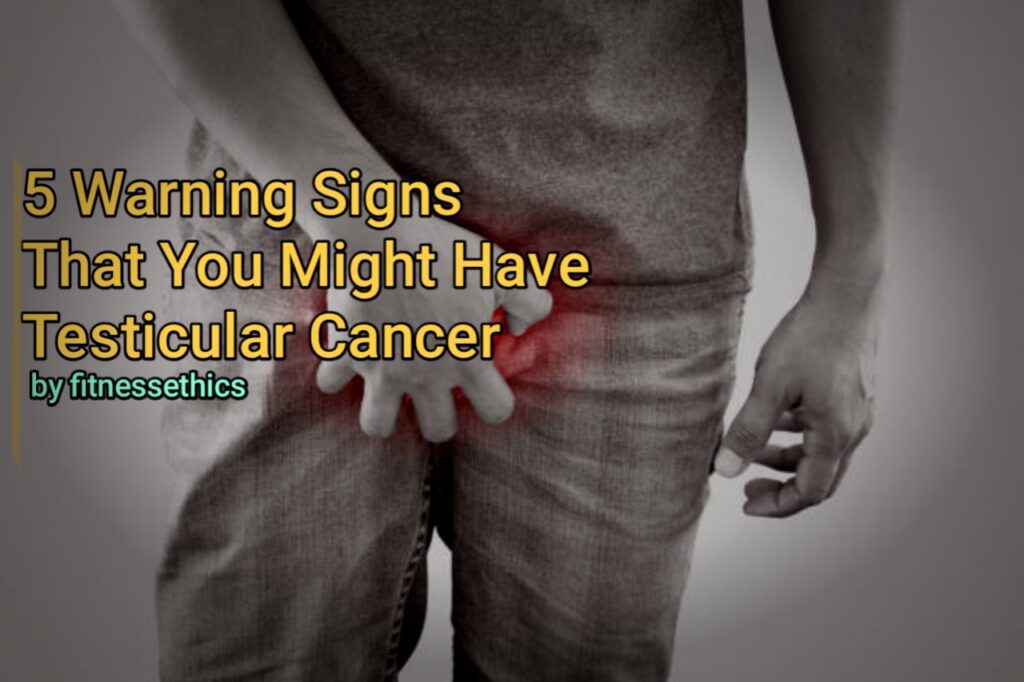Testicular cancer, which is also called the malignant neoplasm of testis, is a cancer of the male reproductive organ, specifically the testicles. The testicles are vital organs in a man, located underneath the penile, where they aid in making the male hormone and sperm.

Having testicular cancer isn’t something any man would wish for. Having a lump growing in your testicles would bring discomfort. We’ll be looking at the signs of testicular cancer that we shouldn’t ignore.
1. Lump in the testicles
Just like any other cancer that will develop, testicular cancer starts with a small lump in either of the testicles. This lump may be in the form of a seed-like substance rolling about the testicle when felt. Feelings of heaviness in the scrotum or an unusual shape, probably larger than it’s supposed to be. Varicoceles—swellings caused by swollen and enlarged veins within the scrotum—can also cause a lump in the testicle.hydroceles—swellings caused by a build-up of fluid around the testicle. Epididymal cysts are lumps caused by a collection of fluid in the epididymis (a coiled tube behind the testicles).
Testicular cancer symptoms should be quite obvious to identify, but most men ignore even the slightest changes in their scrotum. Swelling of the scrotum might not actually be as a result of a common testicular cancer. Other underlying diseases and certain conditions like muscle injury, prolonged standing or eating large amounts of salt can also cause swelling in that part. Either way, you should always get a diagnosis when you feel severe pain or a lump in your scrotum.
2. Pain in the lower back
An unusual bit of pain in the lower abdomen, specifically the groin and waist region, should be monitored.
3. Fatigue
Fatigue is a common symptom of cancer, and you may feel tired all over your body. The lack of zeal to do something that you’ve been doing Now, this particular sign might be discarded because fatigue can also be a result of other conditions aside from underlying diseases like physical exertion, lack of physical activity, lack of sleep, being overweight or obese, periods of emotional stress, boredom, grief, and taking certain medications, such as antidepressants or sedatives. As a man, there are things you should always watch out for. Sudden fatigue should always be monitored.
4. Weight Loss
Weight loss or gain for no particular reason at all should be observed. If you’ve lost more than 10 pounds in less than a week for no particular reason at all, then you’re having cancer signs. Weight loss can also be as a result of other underlying diseases, but in the absence of other diseases, cancer can cause weight loss.
5. Painless testicular lump
We talked about a lump on the testicle. What about a painless lum on the testicle? Well, this is also a sign that shouldn’t be ignored. A painless lump in the testicle is called a spermatocele. A spermatocele, also known as a spermatic cyst, is a typically painless, noncancerous (benign), fluid-filled sac that grows near the top of a testicle.

Testicular cancer is more common amongst men and young adults between the ages of 15 and 35. It can occur at any age as well, but most cases fall within that age range. Is testicular cancer inheritable? Well, yes it actually is. If there have been cases of testicular cancer, probably your father or brother have had it, then you’re more likely to have it. Even without having testicular cancer in your family history, you can still have the condition as most men having the cancer don’t have it in their history.
Undescended testicles (cryptorchidism) are actually the most significant risk factor for those who don’t have it in their history. Studies have shown that around 3 to 5% of boys are born with their testicles inside their abdomen. They usually descend into the scrotum during the first year of life, but in some boys the testicles do not descend.
How can testicular cancer be treated?
Well, just like with every other cancer, it depends on the cancer stage. Actually, there are three stages of testicular cancer; stage 1, 2 and 3. The stage provides a common way of describing how advanced the cancer is so that doctors can work together to plan the best treatment. Stage I is the least advanced, or earlier stage, and Stage III is the most advanced, or later stage.
Treatment includes medication, surgery, radiotherapy, and chemotherapy. Patients will be operated on by three medical professionals.
An urologist is a surgeon who specializes in treating diseases of the urinary system and male reproductive system.
A radiation oncologist is a doctor who treats cancer with radiation therapy.
A medical oncologist is a doctor who treats cancer with medicines like chemotherapy.

Hilary Ojibe is a dedicated medical student with a passion for health and fitness. With a deep interest in understanding how the body works, Hilary enjoys applying medical knowledge to everyday health practices. As a fitness enthusiast, Hilary is committed to promoting a healthy lifestyle and shares valuable insights through articles focused on wellness, fitness and overall health improvement.
[starbox]



